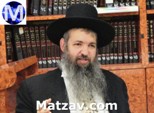Sometimes you have to be a sleuth to uncover hidden messages in the Torah. Here’s a nifty example of an important message encrypted in the formation of the diglei midbar, the way the Bnei Yisroel marched in formation under banners in the desert. There were four banners: the banner of Yehuda, the banner of Reuven, the banner of Ephraim, and the banner of Dan. In the banner of Yehuda, the order of Nesi’im, the Princes, was Nachshon, Nesanel, and Eliav. In the banner of Reuven, it was Elitzur, Shlumiel, and Eliasaf. In the banner of Ephraim it was Elishama, Gamliel, and Avidon. Finally, in the banner of Dan it was Achiezer, Pagiel, and Achira.
Here’s the hidden pattern. Every ‘middle’ Nasi of each banner contains Hashem’s Name (the suffix Ei-l being one of Hashem’s Names). Thus, the middle Nasi of Yehuda is Nessanel. The middle Nasi of Reuven is Shlumiel. The middle Nasi of Ephraim is Gamliel and the middle Nasi of Dan is Pagiel. Furthermore, when you count the number of the middle Nesi’im in the formation, Nesanel is number two, Shlumiel is number five, Gamliel is number eight, and Pagiel is number Eleven. These numbers, 2, 5, 8, and 11 add up to 26, the gematria of Yud, Kei, Vav, Kei: Hashem’s ineffable Name. The Chida says that this “middle” presence of Hashem is alluded to in the verse, “Ki Ani Hashem hashochen besoch Bnei Yisroel – For I am Hashem Who dwells in the middle of Bnei Yisroel.”
Okay, so we found a fascinating pattern. What’s its message? I believe, that it teaches us that Hashem is to be found when people follow the middle path in life. The middle path is what is called by the Rambam the shvil hazahav, the golden road, or the derech ha’emtza, the middle path. In other words, Hashem is found by people who behave normal, those who aren’t towards the extreme. Anatomically, the tallest finger on everyone’s hand is the middle finger; the smallest are the thumb and the pinky. This is a reminder that one who walks the middle path stands tall while radical extremist behavior is very, very small.
But, here’s the rub. What is normal? Everyone thinks they are normal. Just like we live in a world of relative morality, we consider euthanasia murder while others consider it compassionate. We consider abortion snuffing out a life while others consider it the height of human rights. So to, there is the problem of relative normalcy. We all believe that we are normal, but how can we ascertain what’s really normal?
This question is addressed by one of the greatest Jews in the history of our people. Rebbe Yehuda HaNasi, respectfully known as Rebbe, asks in the beginning of the second chapter of Pirkei Avos, “Eizeh hu derech yeshara she’yavor lo ha’adam? Kol she’tiferes le’oseha v’teferes lo min ha’adam – What is the straight path that a person should choose in life? That which brings him or her the respect and splendor of their Creator and the people around them.” Rebbe is advising us that the litmus test to know whether something is normal is to see if such behavior is both good with Hashem and the people around you.
Here’s how this works. If you’re talking in shul in middle of davening, it might feel normal because all your good friends are talking with you. But, it’s not normal for it doesn’t bring you the respect for Hashem. On the other hand, if you’re davening with great concentration and shuckling as if you had Saint Vitus Dance, it might feel normal since you’re really into it with Hashem, but it’s really not normal since the people around you think you are weird. The barometer of true normalcy is to strike a balance that allows you to be pleasing in the eyes of Hashem and the people around you.
This is a surprising intent of a posuk we say before blowing the shofar. “Ashrei ha’am yodei teru’ah; Hashem be’or panecha yehalechun – Fortunate is the Nation who knows the teru’ah sound; Hashem in the light of Your countenance we travel.” What does it mean to be a yodei teru’ah? The Mosak Ha’or suggests that since we blow the sequence tekiah, teru’ah, tekiah, the teru’ah is always the middle note. Thus, the verse means, “Fortunate is the nation who knows how to choose the middle path. It is then that we travel with Hashem.” In Torah Judaism, anything ‘too’ is frowned upon. Too stingy, too generous, too busy, too idle etc.
May it be the will of Hashem that we develop the smarts to achieve true normalcy and in that merit may Hashem bless us with long life, good health, and everything wonderful.
Sheldon Zeitlin takes dictation of and edits Rabbi Weiss’ articles.
To receive a weekly cassette tape or CD directly from Rabbi Weiss, please send a check to Rabbi Moshe Meir Weiss, P.O. Box 140726, Staten Island, NY 10314 or contact him at [email protected]. Visit his website at www.RabbiMosheMeirWeiss.com.
Order Rabbi Weiss’s sefer, Power Bentching,or his pirkay avos cd’s by calling him at 718-916-3100.
Attend Rabbi Weiss’s weekly shiur at the Landau Shul, Avenue L and East 9th in Flatbush, Tuesday nights at 9:30 p.m.
Rabbi Weiss’s Daf Yomi and Mishnah Yomis shiurim can be heard LIVE on Kol Haloshon at (718) 906-6400. Write to [email protected] for details.
Book Rav Weiss now to speak in June and in the Catskills for the summer.
{Matzav.com Newscenter}













Thank you for presenting this article from Rav Weiss. I hope it will be a regular feature.